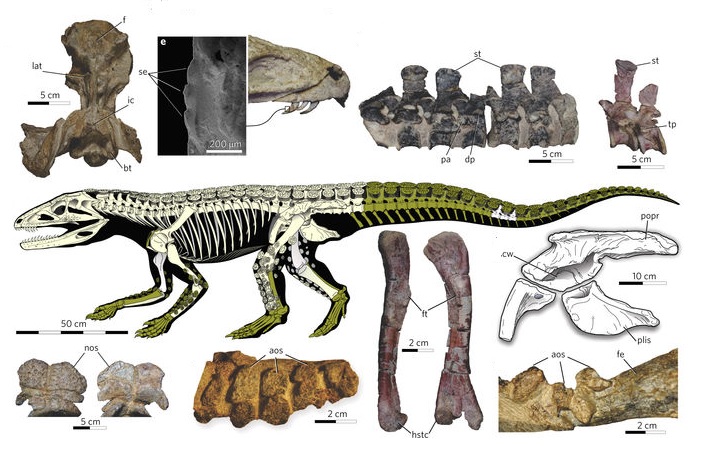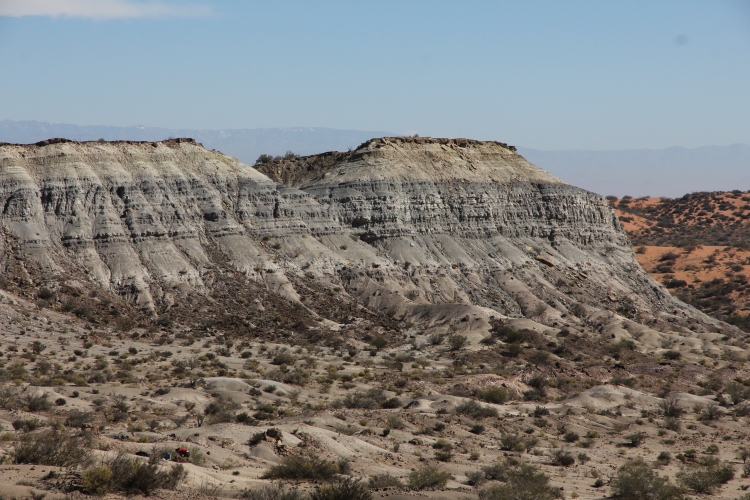
Skeletal anatomy of the erpetosuchid pseudosuchian Tarjadia ruthae. From Ezcurra et al., 2017
In the aftermath of the Permo-Triassic mass extinction (~252 Ma), several typical Palaeozoic synapsids and parareptiles were replaced by stem and crown archosaurs (archosauromorphs) and eucynodonts, and the Late Triassic fossil record of South America has been crucial to shed light on their evolutionary histories.
The Chañares Formation is part of the Ischigualasto-Villa Unión Basin, and represents one of the most continuous continental Triassic succesions in South America. Located in Talampaya National Park (La Rioja Province), the Chañares Formation is characterized at its base by a sandstone–siltstone fluvial facies with distinct lower and upper levels. The lower levels are composed of light olive grey fine-grained sandstones with abundant small brown carbonate concretions. The upper levels include fine-grained sandstones and siltstones that yielded a rich tetrapod assemblage composed of kannemeyeriiform dicynodonts, traversodontid and probainognathian cynodonts, proterochampsid stem-archosaurs, stem-crocodylians, and dinosaur precursors.
Volcanism played an important role in the generation and preservation of the Chañares Formation’s exceptional tetrapod fossil record. Recent radioisotopic datings temporally constrained most of the lower half of this unit to the earliest Carnian (236–231 Ma), showing that this assemblage preceded the oldest members of typical Late Triassic archosaur clades that are found in the Ischigualasto Formation. The new assemblage is called here as the Tarjadia Assemblage Zone, while the upper, historically known assemblage is called the Massetognathus–Chanaresuchus Assemblage Zone. This new assemblage sheds light on the link between the Early–Middle Triassic tetrapod assemblages of Africa (for example, Karoo, Ruhuhu and Otiwarongo basins) and those from the Middle–Late Triassic of South America.

The Chañares Formation (© 2012 Idean)
Tarjadia ruthae is characterized by a dorsoventrally thick skull roof ornamented by deep pits and grooves of random arrangement; Y-shaped tuberosity on the dorsal surface of the anterior end of the parietals; marginal dentition with serrations; spine table of the presacral and anterior caudal vertebrae with a transversely concave dorsal surface; a femur with a poorly developed fourth trochanter and a hook-shaped tibial condyle; and thick dorsal osteoderms with a coarse pitted ornamentation. The abundance of the erpetosuchid Tarjadia in the lowermost levels of the Chañares Formation indicates that this pseudosuchian was an important secondary consumer in its ecosystem
The Tarjadia and Massetognathus–Chanaresuchusassemblage zones currently do not share species or low level taxa, indicating a profound faunal replacement involving both primary and secondary consumers. Therefore, the rise of dinosaurs and other archosauromorph clades that diversified worldwide in the Late Triassic was preceded by a phase of relatively rapid changing ecosystems in southwestern Pangaea, including two (Tarjadia and Massetognathus–Chanaresuchus assemblage zones) profound faunal replacements in a time span shorter than 6 Myr (around 236–231 Ma).
References:
Martín D. Ezcurra, Lucas E. Fiorelli, Agustín G. Martinelli, Sebastián Rocher, M. Belén von Baczko, Miguel Ezpeleta, Jeremías R. A. Taborda, E. Martín Hechenleitner, M. Jimena Trotteyn & Julia B. Desojo; Deep faunistic turnovers preceded the rise of dinosaurs in southwestern Pangaea, Nature Ecology & Evolution (2017) doi:10.1038/s41559-017-0305-5
Benton, M. J., Tverdokhlebov, V. P. & Surkov, M. V. Ecosystem remodelling among vertebrates at the Permian–Triassic boundary in Russia. Nature 432, 97–100 (2004).
Pingback: Fossil Friday Roundup: September 15, 2017 | PLOS Paleo Community